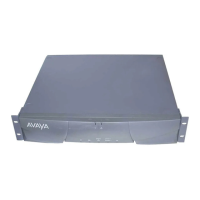Maintenance Object Repair Procedure
555-233-142
8-1042 Issue 1 May 2002
Notes for Sheet 1 through Sheet 6 flowcharts. (When checking for slip errors, use
the previous Table 8-447 on page 8-1037 and Figure 8-40 on page 8-1038.):
1. Use the status synchronization cab # command to determine whether
synchronization is enabled and to determine the on-line reference. If the
on-line reference is a Tone-Clock board, the switch is operating in free run
mode.
2. Check for slip errors against DS1-BD and UDS1-BD.
3. Check for slips errors against TDM-CLK.
4. Check status synchronization cab # for the current DS1 reference. If a
DS1 or UDS1 is on-line, check for slips on that DS1 or UDS1.
5. Check for LOS, Blue, Yellow, and Red alarms on the on-line reference
facility, and fix those problems first. See the DS1-BD and/or UDS1-BD for
the error log entries associated with the previously mentioned alarms.
Replace the circuit packs one at a time and wait at least one hour to
determine if the problem has gone away. This procedure is disruptive and
should be done after hours if possible.
6. If a few facilities are experiencing slips or are unusable references, the
clock source for facilities with slips or that are unusable is not traceable to
the same ultimate source as the clock source for the on-line reference
facility.
Examine the overall timing network for the interconnected DS1 to
determine if the:
■ Clock can be traced back to a single source
■ Reference designations for each location in the distribution of timing
is supplied in accordance with the customer’s synchronization plan
Examine the capability of the external transmission equipment to pass or
provide timing.
Verify the integrity of the on-site hardware by using the technique, ‘‘Facility
Fault Sectionalization’’ on page 8-1043, which:
■ Loops the transmit signal to the receive signal
■ Verifies that the excessive slips or the unusable reference are no
longer observed
This is a time consuming process that disrupts service. You should
perform it after hours if the service being provided by the system is
acceptable as determined by checking with the customer.
7. Use status synchronization cab # to determine the on-line reference. If a
DS1 reference is not on-line and the local oscillator of a Tone-Clock board
is on-line, then the answer to this question is no.
8. Use list synchronization to find out what references, if any, are
administered. Use status synchronization cab # to find out whether
synchronization is enabled.

